| Notes to the financial statements |
notes 1 - 9 |
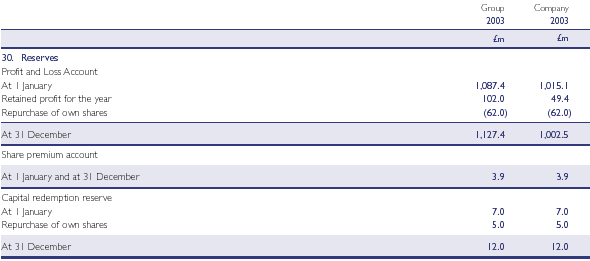
31. Derivatives and other financial instruments
(a) Financial instruments and risk management
The Group’s core business is to provide its customers with financial products appropriate to their needs, from mortgages and savings accounts to
long-term investment products and insurance products.The Group uses wholesale financial instruments to invest in liquid assets and to raise funds
from wholesale money markets in support of its retail savings and mortgage operations.These instruments also allow it to manage the risks arising
from these business activities.
The Group has a well established formal structure for managing risks which includes formal risk policies, risk limits, reporting structures, mandates and control procedures.The Group’s approach to risk management and control is set out within the Financial Review.The Board delegates the management of all aspects of market and liquidity risk to the Asset and Liability Management Committee (ALCO).
Financial instruments used by the Group for risk management purposes include off-balance sheet or derivative instruments. Such instruments are used only to limit the extent to which the Group will be affected by changes in interest rates and exchange rates. As part of its responsibilities, ALCO approves the use of specified off-balance sheet instruments within approved limits and business activities.
The Group does not undertake transactions for trading or speculative purposes and consequently all off-balance sheet financial instruments are classified as hedging contracts.The principal off-balance sheet instruments used by the Group in managing its balance sheet risk exposures are interest rate swaps, interest rate options, cross currency interest rate swaps and foreign exchange contracts.These are used to protect the Group from exposures arising principally from fixed and capped rate mortgage lending, fixed rate savings products, deposit funding, foreign currency exposure and investment activities.The duration of off-balance sheet contracts is generally short to medium-term and their maturity profile reflects the nature of exposures arising from underlying business activities.
At the year end the Group had no net material exposure to foreign exchange fluctuations or changes in foreign currency interest rates.
(b) Interest rate risk
The following tables analyse the repricing periods of Group assets and liabilities at 31 December 2003 and 31 December 2002 respectively:
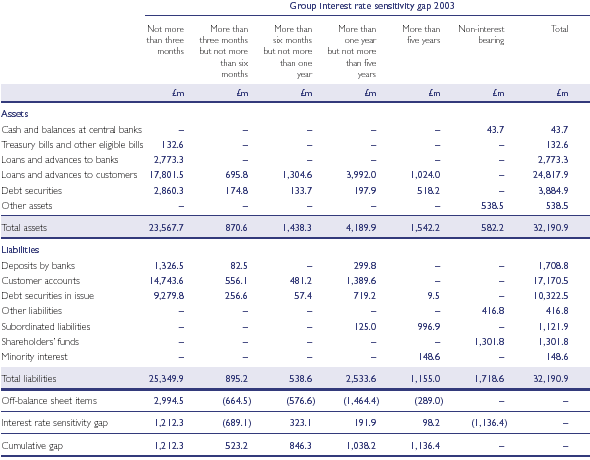
A positive interest rate sensitivity gap exists when more assets than liabilities re-price during a given period. Although net interest income tends to benefit from a positive gap when interest rates are rising (and a negative gap when rates are falling), the actual effect will depend upon a number of factors, including the extent to which repayments are made earlier or later than the next reset or maturity date.
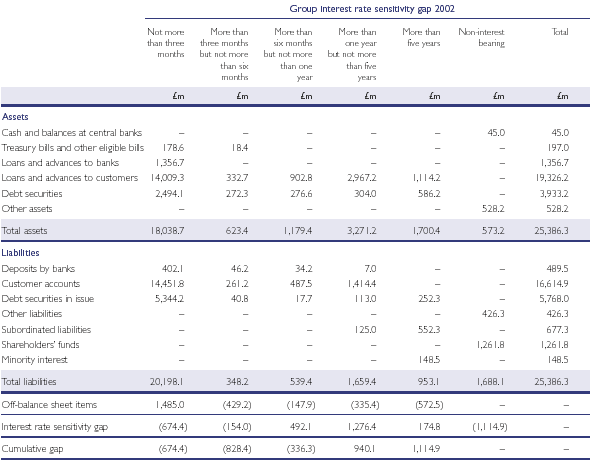
(c) Fair values of financial assets and financial
liabilities
Set out below is a comparison of carrying values and fair values of certain of the Group’s financial assets and financial liabilities at 31 December
2003.The Group does not undertake transactions for trading or speculative purposes.The table excludes certain financial assets and financial
liabilities which are not listed or publicly traded, or for which a liquid and active market does not exist. It therefore excludes items such as
mortgages, customer accounts and deposits with banks.
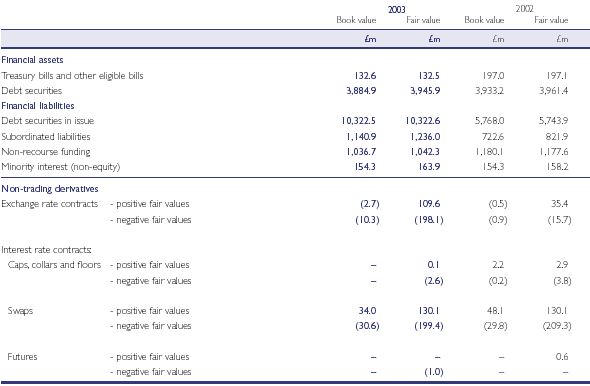
The above figures include accrued interest.
Where a market exists, market values have been used to determine the fair value of debt securities issued and held. Where no market exists, discounted cash flow techniques have been used to determine the fair value using market interest rates for the relevant assets.The fair values of off-balance sheet financial instruments have been determined using market interest rates in discounted cash flow techniques. Fair values of interest rate caps and collars have been calculated using option-pricing models.
The fair values of off-balance sheet financial instruments used as hedges are recognised when the exposure that is being hedged is recognised.The table below shows how these fair values have been, or are expected to be, recognised in the Profit and Loss Account.
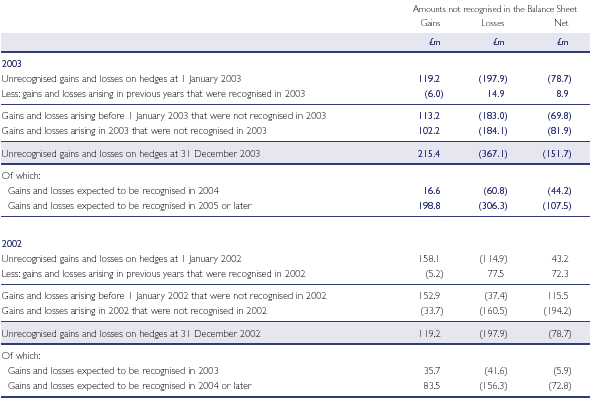
Deferred balances relating to settled derivatives and other financial transaction provisions, used as hedges, will be released to the Profit and Loss Account in the same periods as the income and expenditure flows from the underlying hedged transactions.The above table shows the gains and losses on off-balance sheet derivative instruments used for hedging by the Group.The gains and losses therefore do not represent absolute gains and losses expected by the Group as they will be substantially offset by corresponding losses or gains from on-balance sheet instruments.
(d) Interest and exchange rate instruments
Set out below is the residual maturity analysis of the underlying principal amounts of ‘over the counter’ (‘OTC’) and non-margined exchange
traded derivatives at 31 December. These are all held for asset and liability management purposes:
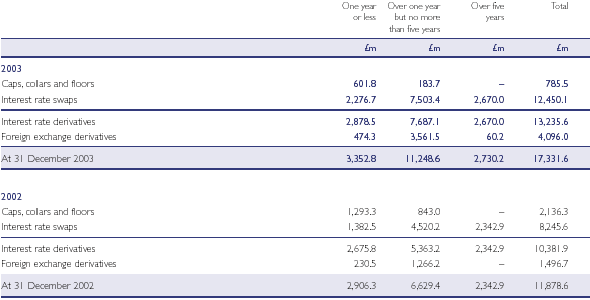
Set out below is the residual maturity analysis of the net replacement cost of OTC and non-margined exchange traded derivatives at 31 December.
These are all held for asset and liability management purposes:
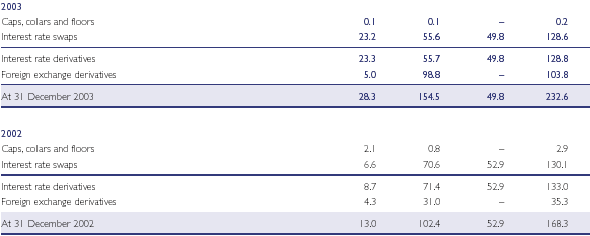
Substantially all of the Group’s derivatives activity is contracted with financial institutions. Replacement cost is calculated by marking to market the
value of contracts and aggregating those with a positive value.
(a) Pension schemes
The Company operates a funded defined benefit staff pension scheme, the Bradford & Bingley Staff Pension Scheme (‘the principal scheme’),
administered by trustees, which is a closed scheme.The fund is independent from those of the Company.The normal pension age of employees in
the scheme is 60 years. Pension costs in the principal scheme are assessed in accordance with the advice of a qualified actuary using the projected
unit method.The most recent actuarial valuation of the scheme was at 31 October 2003.The aggregate actuarial value of the scheme’s assets was
sufficient to cover 110% of the aggregate benefits that had accrued to members, after allowing for expected future increases in earnings.
The aggregate market value of the scheme’s assets held at 31 October 2003 was £352.6 million.
The assumptions which have the most significant effect on the results of the valuation are those relating to the rate of return on investments and the rates of increase in salaries and pensions.The rate of return on investments has been assumed to exceed the rate of salary increases by 2.75% per annum and to exceed the rate of present and future pensions increase by 3.25% per annum.This latter assumption is different from that used by the Company and Trustees in determining the contribution rate to the scheme where the investment return is assumed to exceed the rate of pension increase by 2.25% per annum.
The pension charge takes account of the surpluses disclosed, which are amortised over a period of 11.5 years, being the estimated average remaining service life of pension scheme members.
The Group also operates two further defined benefit schemes which are not material.
The Group operates a defined contribution scheme, the Bradford & Bingley Group Pension Plan.The fund is independent from those of the Company.
The total pension cost for the Group was £13.0m (2002: £10.7m) and included £0.2m (2002: £0.2m) in respect of pensions to former Directors which was charged to other administrative expenses.There were no liabilities or prepayments associated with the defined contribution scheme at the year end (2002: £Nil).
(b) Other post-retirement benefits
The Company provides concessionary rate mortgages and health care benefits to some of its pensioners.The cost of health care benefits is
provided for in accordance with the stated accounting policy.The cost of concessionary rate mortgages is not significant and is recognised in the
Profit and Loss Account as it is incurred.
(c) Financial Reporting Standard No.17 'Retirement
Benefits'
Whilst the company continues to account for pension costs in accordance
with Statement of Standard Accounting Practice 24 ‘Accounting for Pension
Costs’, the following transitional disclosures are required by FRS
17 ‘Retirement Benefits’:
The major assumptions used in this valuation were:

The SSAP 24 valuation at 31 October 2003 has been updated by the actuary on an FRS 17 basis at 31 December 2003. The assumptions used by the actuary are the best estimates chosen from a range of possible actuarial assumptions which, due to the timescale covered, may not necessarily be borne out in practice.
The fair value of the schemes’ assets, which are not intended to be realised in the short-term and may be subject to significant change before they are realised, and the present value of the schemes’ liabilities, which are derived from cash flow projections over long periods and thus inherently uncertain, were:
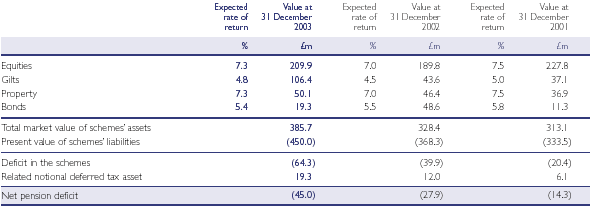
Under the FRS17 transitional rules, the following disclosure is provided
on the performance statements for the years ended 31 December:
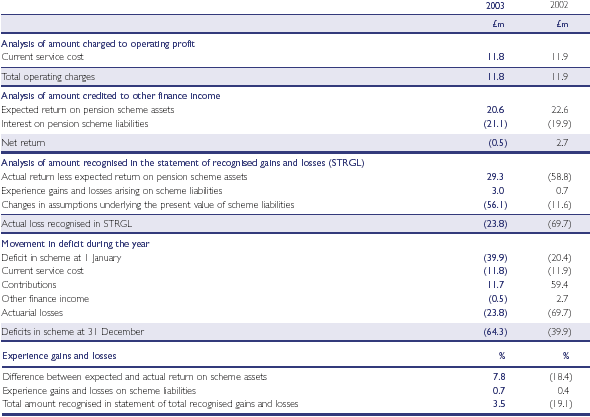
34. Assets and liabilities denominated in foreign currency
The aggregate amounts of assets and liabilities denominated in foreign
currencies were as follows: 
The Group’s policy is to hedge all material foreign currency exposures through both on and off-balance sheet instruments.
35. Consolidated cash flow statement
(a) Reconciliation of operating profit to net
cash inflow from operating activities 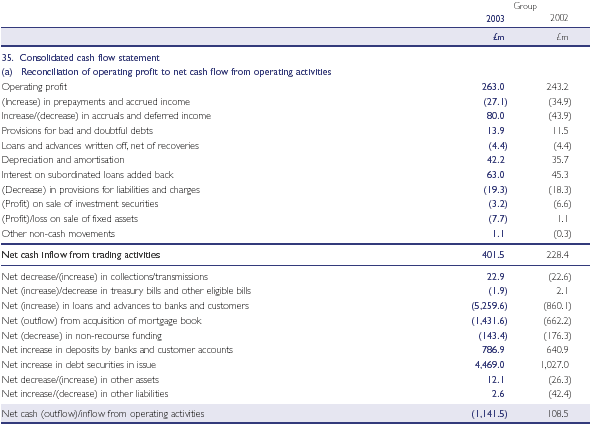
(b) Analysis of changes in financing during the year

(c) Analysis of changes in cash during the year
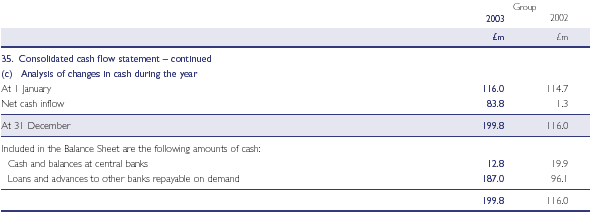
The Group is required to maintain balances with the Bank of England which at 31 December 2003 amounted to £30.9m (2002: £25.1m).
These balances are not included in cash for the purposes of the cash flow statement.
36. Directors' and Officers' transactions
The aggregate amounts outstanding at 31 December 2003 in respect of loans which
were made available by the Group for persons who were Directors of Bradford
& Bingley plc and their connected persons and for Officers of the Company
were: 
37. Capital and leasing commitments
(a) Capital commitments 
(b) Leasing commitments 
The Group reports through three principal business segments: Lending, Savings and Distribution, supported by Treasury and Group Services. An
analysis of the Group profit on ordinary activities before tax and Group total and net assets is provided in the table below:
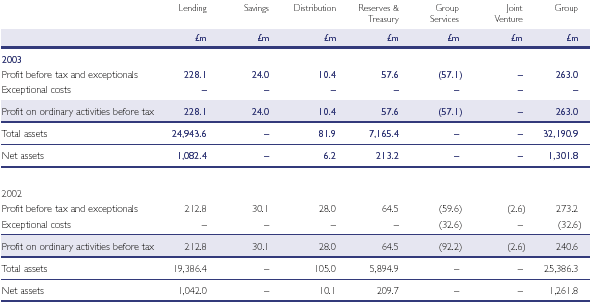 Notes
Notes
(a) In order to analyse net interest by business segment it is necessary
to apply a transfer price to the internal funding or liquidity requirement
of each segment. Interest rates used for transfer pricing have been determined
to retain the interest rate risk within Treasury. Costs have been assigned
to each segment based on resources consumed.Transfer pricing in respect
of mortgage origination by the Distribution segment has been determined
on the basis of market rates for such activity.
(b) Exceptionals have not been allocated across business segments since they are the consequence of Group-level decisions.
(c) For the purposes of segmental information net assets have been allocated to Lending, Savings and Distribution on the basis of the regulatory capital framework.The segments are not allocated capital during the normal course of business, therefore segmental profits do not relate to these net assets.
(d) The Group operates entirely within the retail financial services sector and accordingly no segmental analysis of turnover has been presented. Please refer to the Financial Review for more information on segmental performance.
39. Acquisitions of businesses
The following acquisitions have been accounted for using the acquisition method of accounting:
The entities were acquired for a total consideration of £20.0m, including acquisition expenses of £0.5m. Deferred consideration amounted to
£8.2m, of which £0.8m was contingent on achieving certain performance criteria.
The impact on the Group’s Balance Sheet of those acquisitions is set
out below:
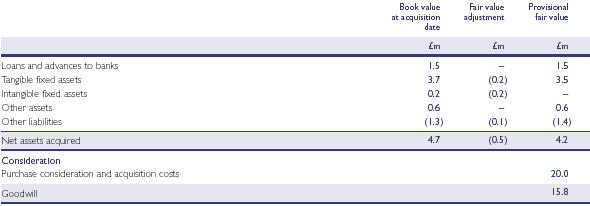
The fair value adjustments are caused by the alignment of accounting policies, a re-assessment of certain provisions and the write-off of previously
capitalised goodwill.
